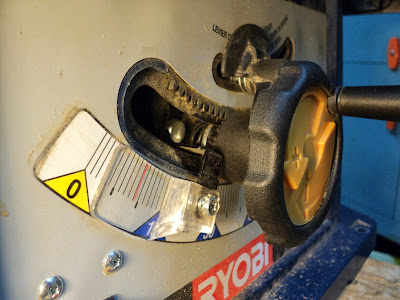I was given a broken down old BTS12S that I've been restoring to working order. I've got the saw running, but there's a curious problem with the 'bevel'/tilt[1] mechanism. Permit me to back up a little, and describe the whole elevation/tilt operation of the machine.
On the BTS12S, a single handwheel operates both blade elevation and blade tilt. The default position of the handwheel is for it to engage the elevation screw. Pushing the handwheel in against a spring disengages it from the elevation screw, and engages a rack-and-pinion gear set that operates the tilt function. The problem I have with the machine is that the rack-and-pinion gear teeth barely engage one another deeply enough to work -- the teeth mostly just skip to no effect. I can see no adjustment to improve the gear teeth engagement. Here's a view of what I've just been on about.
Everything about the mechanism appears to be factory-issue, which says that the tilt function on this saw has never worked, right from day one. That likely wouldn't have mattered to the guy who gave me the saw, because he was only using the saw to cut up shipping pallets into firewood. Regardless, whether I keep this saw or give it to someone, I'd like for the tilt function to work as it ought to.
From what I can see so far, it looks to me like the elevation screw emerges at the front of the saw too low down for the rack-and-pinion gear set to ever engage properly. I need to see if there's a way I can alter that, without fouling up the elevation function.
- - -
Here's a view of the front of the saw upside down with the handwheel and elevation screw removed.
Note the position of the large washer just inside the tilt slot where the elevation screw emerges -- it's not centred, it's almost as far away as possible from the rack. It's beginning to look to me like Ryobi got a dimension wrong, and may have made many of these saws with this same defect.
I've removed the washers and spring that are immediately behind the tilt slot, to get a direct view of the hole in the tilt carriage that the elevation screw emerges from. Here's a shot of that.
The photograph shows it poorly because of a shadow, but that hole is way too far from the rack for the elevation handwheel's pinion to ever engage the rack fully.
I'll try elongating that hole in the direction of the rack, so that the elevation screw can be manually forced toward the rack when the tilt function is engaged.
- - -
Well, the job I did of elongating the hole with a hand grinder is not pretty, but it did yield the outcome I was after; it's now possible to force the rack-and-pinion to engage fully. The tilt function is operable throughout its entire range.
Conclusion
I'm normally disinclined to condemn a piece of engineering, I know that there are many compromises that must be made, but for this tilt mechanism I'll go right ahead and condemn. The tilt mechanism is, in a word, shabby. It never should have left the factory. What respect I ever may have had for Ryobi has taken a nosedive with this little exercise. I consider such marginality in a mass-produced, low tech piece of gear to be inexcusable.
If you're shopping for a legitimate woodworking machine for cabinet making and the like, steer clear. If you're looking for a firewood cutter, the Ryobi will serve. That's the class it's in, after all.
- - -
Note:
[1] Ryobi insists on referring to 'tilt' as 'bevel'. Tilt and bevel are not the same thing; bevel is an effect, tilt is a cause. Setting the blade's angle to something other than ninety degrees via the tilt mechanism bevels nothing -- it merely tilts the blade. Cutting wood with the blade tilted results in a bevel.
It appears that Ryobi's grasp of English is as marginal as its tilt mechanism.
# # #
# # #


